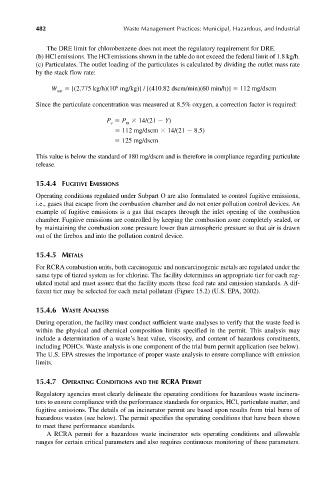Page 511 - Materials Chemistry, Second Edition
P. 511
CAT3525_C15.qxd 1/27/2005 12:40 PM Page 482
482 Waste Management Practices: Municipal, Hazardous, and Industrial
The DRE limit for chlorobenzene does not meet the regulatory requirement for DRE.
(b) HCl emissions. The HCl emissions shown in the table do not exceed the federal limit of 1.8 kg/h.
(c) Particulates. The outlet loading of the particulates is calculated by dividing the outlet mass rate
by the stack flow rate:
6
W out [(2.775 kg/h)(10 mg/kg)] / [(410.82 dscm/min)(60 min/h)] 112 mg/dscm
Since the particulate concentration was measured at 8.5% oxygen, a correction factor is required:
P P 14/(21 Y)
m
c
112 mg/dscm 14/(21 8.5)
125 mg/dscm
This value is below the standard of 180 mg/dscm and is therefore in compliance regarding particulate
release.
15.4.4 FUGITIVE EMISSIONS
Operating conditions regulated under Subpart O are also formulated to control fugitive emissions,
i.e., gases that escape from the combustion chamber and do not enter pollution control devices. An
example of fugitive emissions is a gas that escapes through the inlet opening of the combustion
chamber. Fugitive emissions are controlled by keeping the combustion zone completely sealed, or
by maintaining the combustion zone pressure lower than atmospheric pressure so that air is drawn
out of the firebox and into the pollution control device.
15.4.5 METALS
For RCRA combustion units, both carcinogenic and noncarcinogenic metals are regulated under the
same type of tiered system as for chlorine. The facility determines an appropriate tier for each reg-
ulated metal and must assure that the facility meets these feed rate and emission standards. A dif-
ferent tier may be selected for each metal pollutant (Figure 15.2) (U.S. EPA, 2002).
15.4.6 WASTE ANALYSIS
During operation, the facility must conduct sufficient waste analyses to verify that the waste feed is
within the physical and chemical composition limits specified in the permit. This analysis may
include a determination of a waste’s heat value, viscosity, and content of hazardous constituents,
including POHCs. Waste analysis is one component of the trial burn permit application (see below).
The U.S. EPA stresses the importance of proper waste analysis to ensure compliance with emission
limits.
15.4.7 OPERATING CONDITIONS AND THE RCRA PERMIT
Regulatory agencies must clearly delineate the operating conditions for hazardous waste incinera-
tors to ensure compliance with the performance standards for organics, HCl, particulate matter, and
fugitive emissions. The details of an incinerator permit are based upon results from trial burns of
hazardous wastes (see below). The permit specifies the operating conditions that have been shown
to meet these performance standards.
A RCRA permit for a hazardous waste incinerator sets operating conditions and allowable
ranges for certain critical parameters and also requires continuous monitoring of these parameters.

